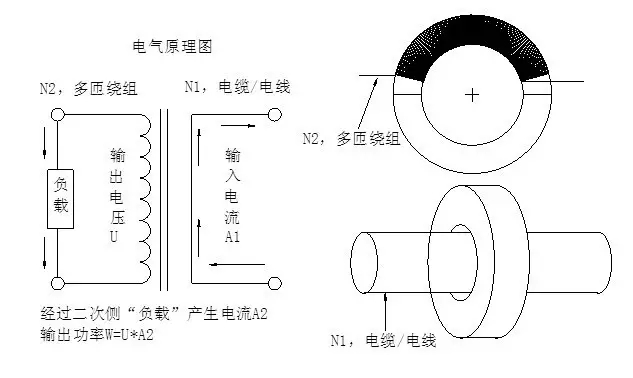
Application of electromagnetic core in fault indicator acquisition unit
publish time:2019-11-26 18:26:321. Power on principle of acquisition unit
The current induction of fault indicator acquisition unit uses the electromagnetic induction principle of "dynamoelectric generation of magnetism, dynamoelectric generation of electricity" to generate voltage and current on the secondary coil through permalloy magnetic core electromagnetic coupling, so as to realize the transmission of power and achieve the purpose of power extraction on the self conducting wire.

As shown in the figure, when the primary current flows through the primary winding N1, an alternating magnetic flux Φ 1 is generated in the core magnet. The alternating magnetic flux Φ 1 passes through the core magnetic circuit, and the induced voltage U is generated on the secondary side winding. Compared with other electromagnetic transformation, the primary winding here is cable or conductor, and the number of turns is 1.
In the process of forming a closed circuit in the magnetic core, the alternating flux Φ 1 will be hindered by the magnetic resistance Φ R, magnetic space radiation (magnetic flux leakage Φ L), and some of the flux will be lost. Only the part of flux Φ 2 passing through the secondary winding can effectively transfer the electric energy to the secondary side, that is, Φ 1 = Φ L + Φ R + Φ 2. It can be seen that under the same working condition, the smaller the magnetic resistance Φ R and magnetic flux leakage Φ L are, the larger the output power of the secondary side will be.
Because the permalloy core acquisition unit needs to meet the requirements of live installation and disassembly, the core needs to adopt the cutting and fastening mode, that is, the core needs to be cut into two parts during production, and then closed to form a circular magnetic circuit during installation. When the magnetic circuit is closed, the air gap will be generated due to the cutting gap. Compared with the original ring magnetic core, its magnetic resistance Φ R and magnetic flux leakage Φ l will greatly increase. Under the same working condition, the better the cutting process is, the smaller the air gap is, the smaller the magnetic resistance Φ R and magnetic flux leakage Φ l will be, and the greater the output power of the secondary side will be.
In order to reduce the loss of the magnetic circuit and improve the output power level of the secondary side under the same conductor current, it is necessary to use the core material with high permeability and high saturation flux density BS value to make the material selection of the core material tend to be high-end. Through our experiments, the materials that meet the power requirements of fault indicator acquisition unit are: permalloy 1l85, iron-based nanocrystalline 1k107
Physical / magnetic properties of magnetic materials:

2. Relationship between magnetic flux and power / correlation calculation between theoretical formula:
(1) 1=B*Ae
(2) B= *H
(3)μ=AL*Le/0.4*π* N²*Ae(N²=1)
(4) H=0.40π*N*I/Le
Among them:
μ: permeability
B: flux density
AE: cross sectional area of magnetic core
H: magnetic field strength
Al: inductance
Le: equivalent magnetic circuit length
It can be seen that under the same primary current, the higher the permeability μ is, the shorter the equivalent magnetic circuit length Le is, the larger the cross-sectional area AE is, and the larger the primary magnetic flux Φ 1 is.
In order to minimize the loss of Φ R and Φ L after the primary magnetic flux is transferred to the secondary side, it is necessary to reduce the loss of magnetic resistance and magnetic leakage, that is, to improve the permeability, optimize the effective magnetic circuit length of the magnetic core and adopt excellent technology to ensure the close fit of the cutting surface of the magnetic core. In our actual processing practice, the permeability of 1k107 iron-based nanocrystalline core after cutting can reach more than 15000, and the permeability of 1J85 permalloy core after cutting can reach more than 12000. What is the permeability of permalloy core after cutting? To be decomposed in the next set.
3. Analysis of the cause of the burnout of the power take-off coil
Because the power take-off coil works under the power frequency condition, the core eddy current will not cause too much iron loss under the condition of reasonable design of magnetic core, so permalloy core magnetic core will not be burnt out, and the on-site burning out is mainly caused by the improper design of secondary winding.
When the working current of the primary side of the fault indicator rises, the output current of the secondary side will also rise correspondingly, that is to say, it meets the requirements of I1: I2 = N1: N2. Therefore, the wire diameter of the winding copper wire should be considered according to the possible continuous maximum current on the primary side wire, and the current density on the winding should not be too large, otherwise the winding will generate high heat, resulting in the burning of the coil.
4. Example application
1J85 (0.2mm permalloy) and 1k107 (0.025mm iron-based nanocrystalline) are super high permeability soft magnetic materials. Under the power frequency condition, the eddy current loss can be almost ignored. In the current application of fault indicator acquisition unit, its excellent magnetic properties are incomparable to other permalloy core magnetic materials. The core price between 1J85 and 1k107 is about 2:1. In large-scale applications, 1k107 has advantages in magnetic properties and price.
 Scan WeChat for advice
Scan WeChat for advice
 Scan WeChat for advice
Scan WeChat for advice